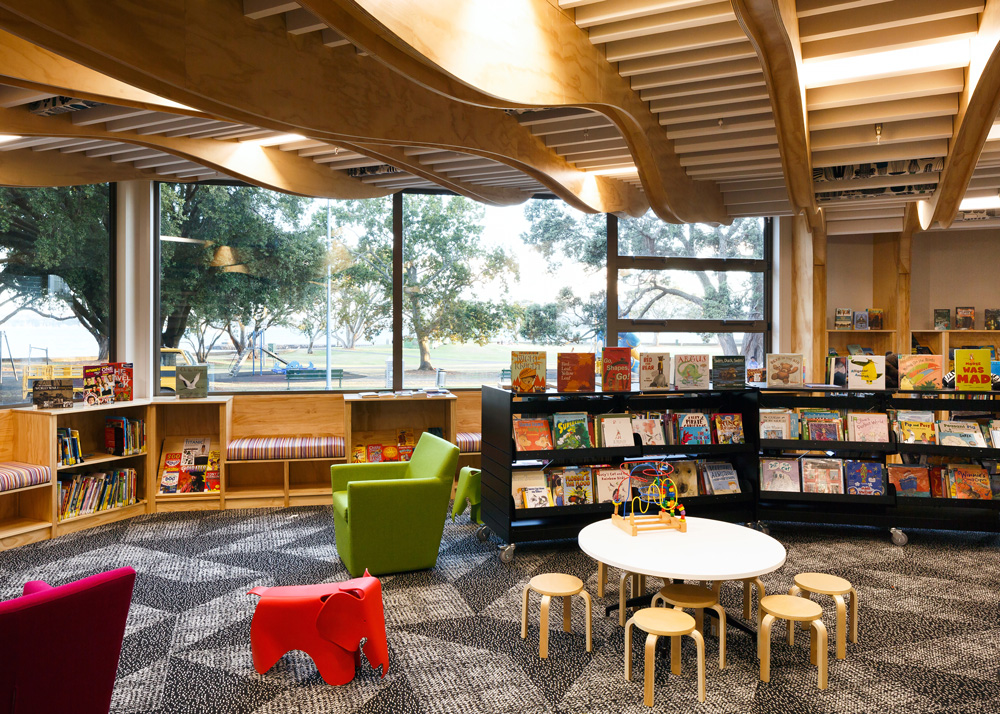May 22, 2015 Urban design
This story first appeared in the April 2015 issue of Metro. Photos by Jason Mann.
The whining about the $7.8 million Devonport library, opened in February, refuses to die down. “Why do you need a flash dispensary of books and other media to enjoy literature?” asked Robert Weber in a particularly bah-humbug letter to the Flagstaff newspaper. The local buzz, he railed, was all about the library’s aesthetic merits and “how many youngsters will take up reading because of this cool new building”.
Upgrading the existing building would have been the “fiscally, environmentally, historically and culturally responsible choice” — an option, he claimed, that was never put to the community, “let alone the more basic question of whether we will need a dedicated library building in the future”.
Robert is not alone. John Allen complained about the library contents. Fiction reigned and the non-fiction section had been gutted, especially on marine topics. He seemed to be offended when he visited by the spectre of “seven people sitting downstairs (excluding the children’s section), none with books and either talking or fiddling with their smartphones”.
To his credit, John did say: “The new library building is gorgeous, fitting into the treed surroundings, drawing readers inside and silencing critics who deemed it an unnecessary extravagance (including me).” Bravo.
The community is embracing this building. When I visit, the children’s section is teeming, a group of pre-schoolers at home on the purpose-made furniture conversing animatedly while brandishing colourful electronic tablets. A mother on a beanbag is reading a book to the child on her lap. The ceiling is low curved timber, cut in an undulating wave form and packed with acoustic insulation panels between the ribs to absorb the chatter.
Along the gathering spine, at the desks between the tall and wide timber columns, there’s plenty of activity too — adults and children on stools browsing tethered tablets and books coming and going, either by self-check or staff who, in a more friendly arrangement, stand side-on by a screen and scanner. “It’s not an us-and-them mentality,” says Auckland Libraries’ Mirla Edmundson. “It’s getting staff to be roaming more and working with the customers one-on-one.”
Waist-high display shelves immediately inside the entrance signal another change — the retail model. “That’s not retail in the sense of money exchange, but in terms of display of the collection; taking the lead from good bookstores on how to bring stuff forward,” says the building’s lead designer, Athfield Architects’ Jon Rennie.
Around the corner are four wide steps on which teenagers can lounge, as they do, on multicoloured, striped squabs. The prime spot is the wide sill of the huge, whimsical, circular window framing the greenery of the park outside. The area opens to an outside reading courtyard and the surrounding park, with its old, gigantic Moreton Bay fig trees. There’s another door to the adjacent verandah terrace where you can spot tourists with iPads enjoying the library’s free wi-fi and Skyping friends or family back home. Multiple doors to a library — radical.
The library as pavilion in the park. It opens to the outside via a high verandah around two sides and the transparency of its glazed and ventilating, louvred façade brings the park inside. In places, you can view straight through. The mezzanine level has quieter study spaces, including a perimeter desk that looks out through the pohutukawa of Windsor Reserve to the harbour. Everywhere are comfortable places to sit, including lounge chairs and sofas around gas fireplaces on each level. Just like home.

Robert’s and John’s complaining seems oblivious to something quite miraculous and magical. In a time when all around is digital and old forms of media seem destined for the scrapheap, the library is staging a comeback. A revival that isn’t about books — electronic or actual — but about creating a community living room.
“It’s this notion of the last public space that is serving other needs beyond just a collection,” says Rennie. “It’s not a repository of stuff. It’s a social space and it’s where the role of the librarian is one of curator rather than collector.”
Rennie gets some heavyweight backup from British novelist Zadie Smith, who wrote in a New York Review of Books blog that the new-old library was “the only thing left on the high street that doesn’t want either your soul or your wallet”.
Devonport’s and several other recently completed library buildings — eg, Waiheke, Ranui and Te Atatu — defy technocratic logic: that with every book in the world online there is no need for the physical reality. Clearly there is, and the new libraries — all legacy projects from Auckland councils prior to amalgamation — are testimonies to a community need beyond free books. Amalgamation has, however, helped in bringing together 3.5 million items that library users can borrow from, and return to, anywhere in the network. “Libraries are a non-judgmental, inspiring place for people to be in,” says Edmundson. “More and more people seem to be craving those spaces.”
The key to getting the right architecture for these communal living rooms is consultation. For Devonport, it was a fraught process. A vocal group of architects argued the site should be returned to a park and shouldn’t have a library there at all. Others pointed out a building had been there as early as 1886 — the Council Chambers, which had a reading room added in 1887.
Then there was Toiletgate. “Library plan gives best view to loos,” shouted the NZ Herald. The architects admitted they got that wrong and moved them. They listened to other feedback too and added closed study rooms on the upper level.
Perhaps the most vexed argument was about the 22m dividing curtain — a hand- printed silk artwork by Judy Millar that closes off part of the library to be used for community events. Former North Shore City Council mayor Andrew Williams called the work — costing $107,000 — wasteful and extravagant. Once again, something other than fiscal imperative won the day — a public building, a library should contain public art. The triumph of this architecture is its negotiation of the maelstrom and the constraint of designing within an existing footprint to provide something so integrated and so well used.
Its success is in the meticulous attention to detail — from the black-and-white carpet tiles to the comfortable furniture to the careful modulation of materials on the façade to soften the rather clunky prow of the building around the south- west corner. It shows that to get a good building, debate is good — lots of it, loud and with feeling.





